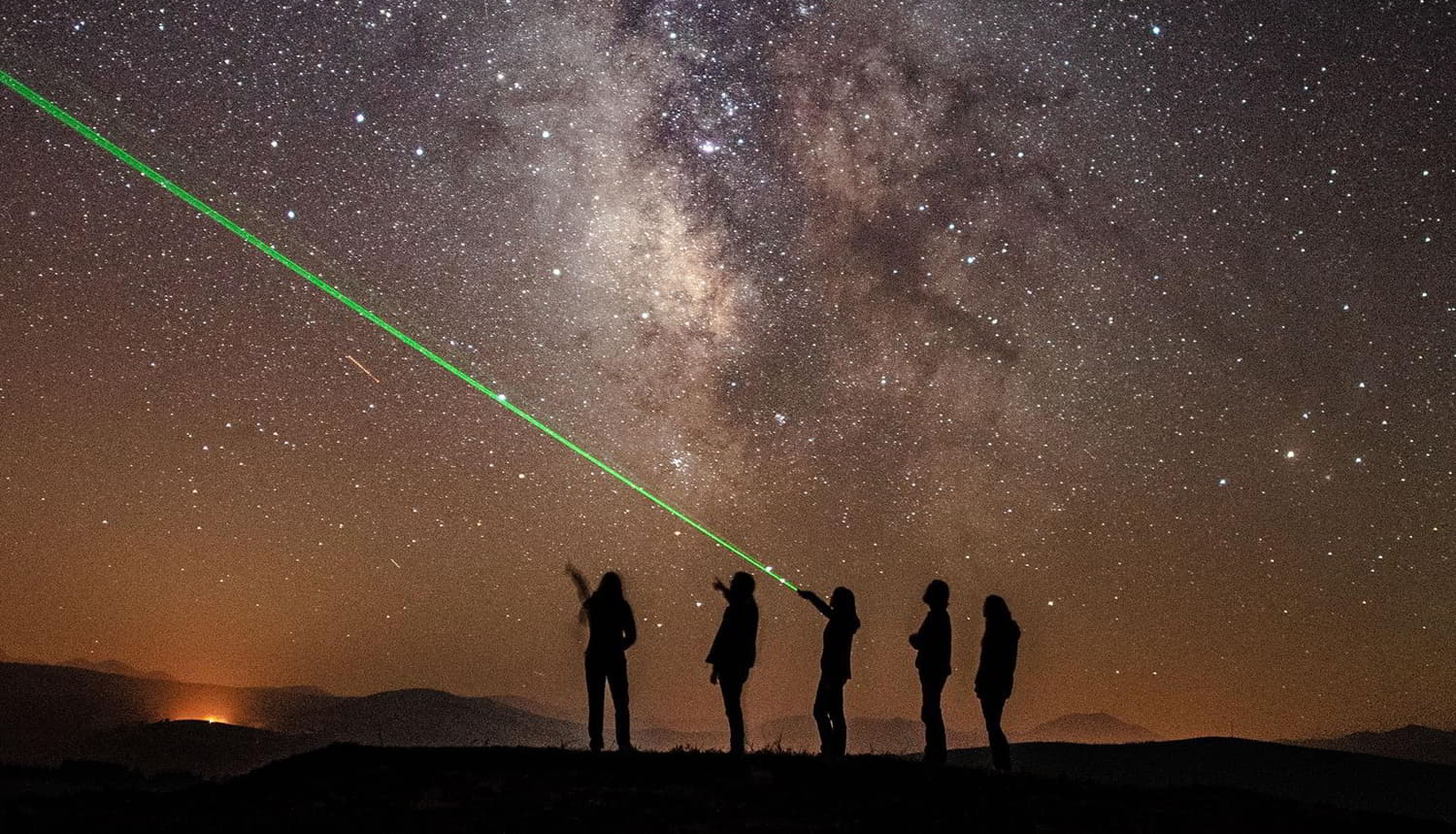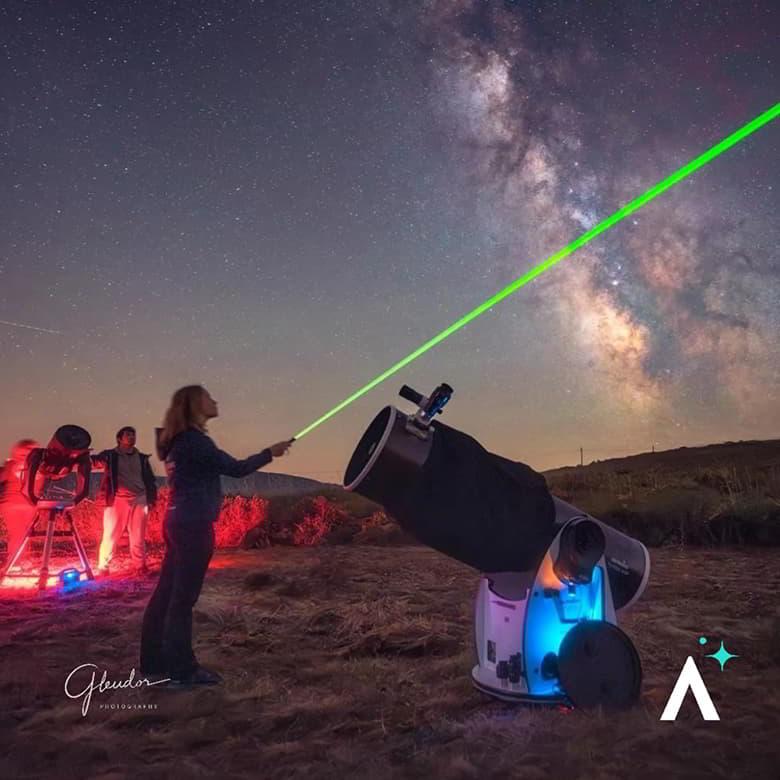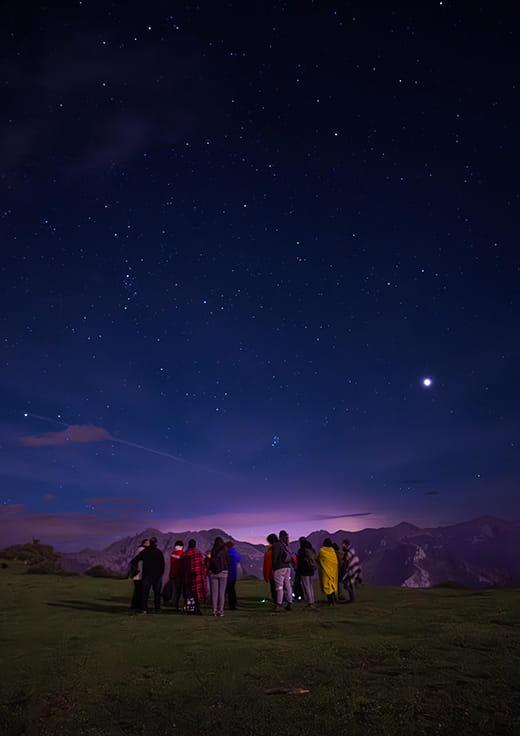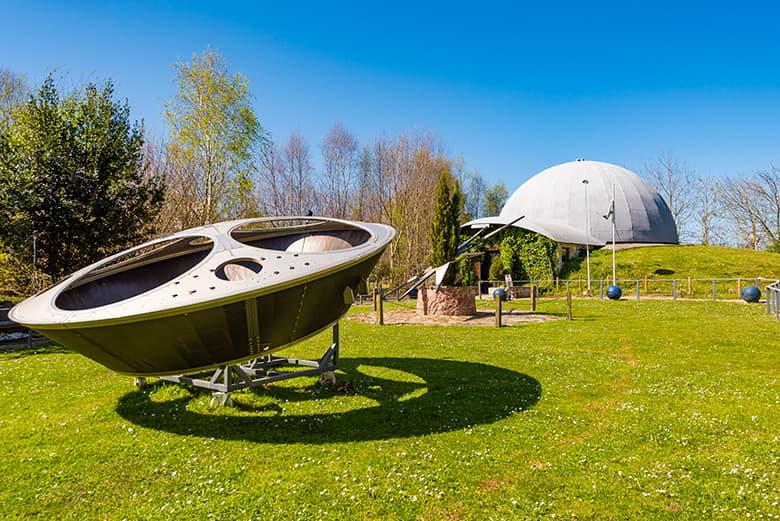Back Astrotourism in Asturias: Where to see the stars

Asturias under the stars: Places for astro-tourism
The vision of the cosmos is breathtaking from places with a great telluric charge. Asturias, without going any further, is full to the brim with natural energy and allows for the best night dives. The hooting of the guruxu (tawny owl), the fluttering of other birds at night, the footsteps of the fauna in the leaf litter, or the mysterious outline of trees and rocks predisposes us to observe the stars with unreflective curiosity.
But if we do not see the poetic side of the matter, or we are overwhelmed by adjectives such as "inexplicable" or "unreachable", we can use science and surround ourselves with specialised guides who will choose the best nights and places for us, and lend us the latest generation of telescopes.
Asturias: stellar observatory
Since ancient times we have learned lessons from the sky. In particular, how to orientate ourselves or measure the passing of time. In nautical teachings, the principles of astronomical navigation are still in force, and flocks of sheep and goats ("reciella" in Asturian) have always needed shepherds who could interpret the stars well.
Nowadays, in order to look at the stars for the pleasure of doing so, areas free of artificial light and pollution blankets are more necessary than ever. And the Asturian orography also facilitates this, with hundreds of high peaks and mid-mountain summits without light interference and with 360-degree panoramic views. Natural areas such as the Picos de Europa, or the rest of our great parks: Redes, Somiedo, Ponga, Ubiñas-La Mesa or Fuentes del Narcea, Degaña and Ibias, as well as a good handful of protected mountain ranges and Biosphere Reserves, enjoy an unbeatable galactic slate.
And then there are the valleys far from the large towns that offer equally dark skies where the stars are at ease. Or numerous areas of the coastline ideal for observing certain phenomena, such as the aurora borealis itself, sighted on several occasions from the northernmost tip of Cabo Peñas and other points along the coastline - Asturias records this spectacle when the sun's activity is particularly intense. The coast is also the best amphitheatre to enjoy the Perseids or "Tears of San Lorenzo" (August), the Geminids (December) or the Quadrantids (January).
Guided tours to the stars
There are more specific areas of the Asturian map where the so-called "astro-tourism" is more present. These are locations that have generated a good "astronomical" fabric in their surroundings.
Allande Stars
The municipality of Allande, for example, with a population of less than 2,000 inhabitants, is one of the most recommended places for stargazing, as well as being the first "Starlight Council" in Spain - certified by the Starlight Foundation, whose actions are part of UNESCO and the International Astronomical Union (IAU).

In the near future, Allande will have an important astronomical observatory. The icing on the cake to its already famous Star Route: a six-kilometre itinerary in the very surroundings of the Primitive Way of St. James, between the shelters of La Marta and Puerto del Palo. For some time now, companies and groups have been operating here offering night-time outings and interpretations of the celestial dome. Such as "Allande Stars", an initiative led by people with degrees in astrophysics.
With Allande Stars, it is possible to contract guided observation services for the night sky or special activities aimed at educational centres or companies. In addition, its website offers detailed information on the astronomical events organised by this group throughout the year. In 2025, three events stand out:
The sixth edition of Allande Stars. It will be held from 22 to 24 August and is the great astronomical meeting of the council of Allande. A weekend full of information, workshops and observations.
The second edition of AstronoMieres to be held on 3 and 4 May.
The third edition of CosmoSomiedo on 27 and 28 September in the spectacular surroundings of the Somiedo Natural Park.
You just have to avoid looking directly at the moon -the guides will tell you- to get your eyes used to the darkness. Little by little, the best known constellations of the northern hemisphere will appear before us: Ursa Major, Orion, Cassiopeia, Andromeda.... after a few minutes we will have the sensation that they are multiplying all the time. The guides will set up good telescopes and offer detailed explanations about our galaxy, black holes and the expansion of the universe - which is no small feat.
Aller Estelar
Aller Estelar is another astro-tourism experience in Asturias, organised by the active tourism company Jarascada. In the spectacular surroundings of Alto de Coto Bello, a natural 360° viewpoint at an altitude of 1,200 metres, astronomical outings are organised during the summer and autumn. Experts in astronomy and astrophotography guide this activity, teaching night-time orientation techniques, such as the location of the north celestial pole, as well as many other curiosities about the cosmos.

Accommodation and astronomical experiences in Asturias
Throughout our geography, other night-time outings, educational workshops or astrophotography events are organised. Some accommodations have observatories and telescopes at the service of their guests, as is the case of the rural flats El Observatoriu, located in Muñas de Arriba, Valdés.
There are also private scientific initiatives, such as the one that takes place in a village in the Redes Park, where a couple of amateurs carry out special monitoring of supernovae, compiling information that they send to Harvard University and collaborating with NASA missions. They are Esteban and Noelia, who run the Estelia observatory in Ladines, Sobrescobio, combining their work in astrophotography and photometry with the dissemination of science and astronomy. They organise events and observations, and they post the best images captured at the observatory on their Instagram.
Monte Deva Astronomical Observatory and Planetarium in Gijón
Gijón is home to the Monte Deva Astronomical Observatory, which opens its doors to the public every Friday for night-time observation sessions, provided conditions are favourable. To ensure better visibility, no activities are held on nights when the moon is full, as its brightness hinders observation. Each session focuses on a specific astronomical event, such as the opposition of a planet, the passage of a comet or a solar or lunar eclipse. To arrange a visit, please contact the OMEGA Asturian Astronomical Society on 985 096 630 (Fridays from 20:00 to 22:00). You can also contact the observatory's management directly: 636 486 342. The day and time of the visit will be by mutual agreement (preferably on Fridays). It should be noted that this facility is attended selflessly by people who do not have an exclusive dedication.

Also in Gijón, after 20 years of closure, a benchmark has reopened its doors: the planetarium of the Escuela Superior de Marina Civil, now equipped with a modern 4K laser projector. A leap from the analogue to the digital system that allows projections of the night and day sky, immersive adventures and travelling through space among asteroids and planets, in high resolution. Although its main function will be training in nautical astronomy, the university is considering opening it up to the general public with a programme of visits and informative activities. It has a room with a capacity for 40 people.
Observatory of the Parque de la Vida in Valdés
Five minutes away from the town of Luarca/Ḷḷuarca, in the village of La Mata, you will come across the Parque de la Vida. This museum is open every day (except Mondays except public holidays). It is essential to book in advance by calling: 689 570 708 or 660 660 400.

It is a large exhibition complex set in a natural space with a route of more than one and a half kilometres. As far as the stars are concerned, its observatory, the themed exhibition on the moon, the real interior of the European Ariane 5 rocket and the spacesuit of the Russian cosmonaut Yuri Usachov stand out. A suit that we will be eager to put on to continue our space adventure.
Asturias can undoubtedly be your best shuttle to the stars.

Subscribe to our newsletter and take advantage of offers, discounts, and news
Subscribe



